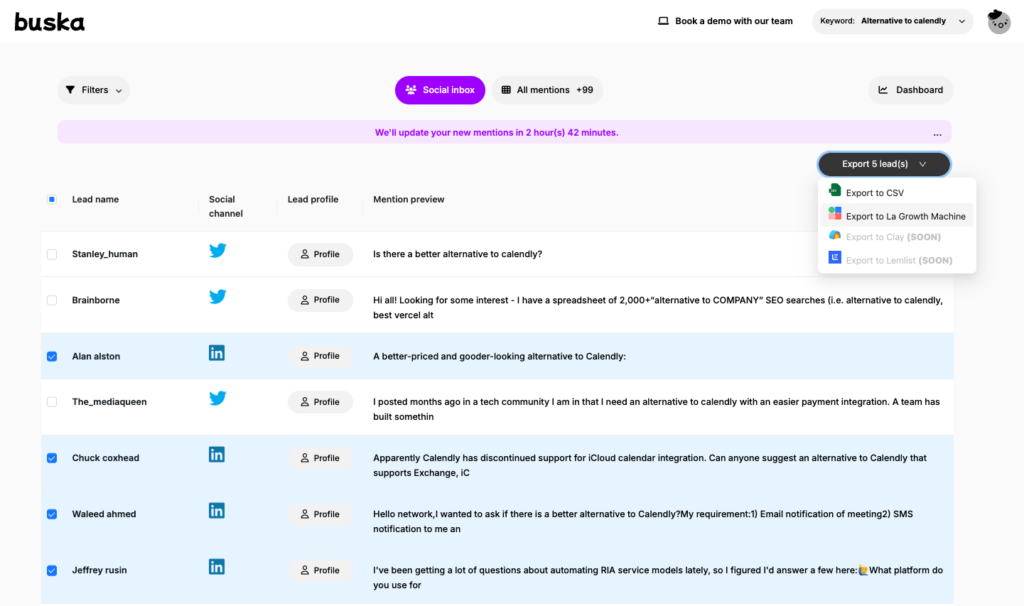"Buyer Intent": cómo utilizar los datos de intención para generar clientes potenciales

Puede influir en la forma de llegar a los clientes aprovechando la intención de compra y encontrar a personas que ya están interesadas en lo que usted ofrece.
Los datos de intención de compra captan señales de acciones en línea -como mencionar un producto específico en las redes sociales, visitar determinadas páginas o descargar contenidos específicos- que muestran la probabilidad de que alguien compre.
Utilizando esta información, los equipos de ventas pueden centrarse en los clientes potenciales de alto interés y crear estrategias para conectar mejor con ellos.

¿Qué es la intención de compra?
La intención de compra muestra lo dispuesto que está un cliente potencial a realizar una compra.
Utiliza datos de comportamientos observados, como qué sitios web visitan, el contenido que leen y cómo interactúan en línea. A través de estas acciones, sabrás en qué están interesados los clientes potenciales e identificarás en qué punto de su recorrido de compra se encuentran.
Por ejemplo, si alguien sigue visitando una página de comparación de productos o lee muchos artículos sobre su solución, probablemente esté a punto de tomar una decisión.
El seguimiento de estas interacciones puede ayudarle a conectar con estos clientes de alto potencial en el momento adecuado.
Tipos de datos de intención de compra
Para sacar el máximo partido de los datos de intención, es importante comprender de dónde proceden.
Los datos de intención suelen dividirse en dos tipos:
- Datos de intención de primera parte:
Suele tratarse de la información recopilada de sus propias plataformas digitales, como Análisis de Google o herramientas CRM.
Si un cliente potencial sigue visitando páginas de servicios específicos, descarga estudios de casos o lee entradas de blog relacionadas, estas acciones demuestran su nivel de interés.
Los datos de origen le ofrecen información directa sobre lo que los clientes potenciales consideran importante, que puede utilizar para interactuar con ellos. - Datos de intenciones de terceros:
Estos datos son recogidos de otros sitios por herramientas de terceros y muestran el comportamiento en diferentes plataformas.
Por ejemplo, si un cliente potencial busca soluciones similares o se interesa por temas relacionados en las redes sociales, demuestra un interés creciente en su campo.
La combinación de estos conocimientos con sus datos le ayudará a comprender mejor a sus clientes potenciales.
Las señales controladas pueden ir desde las visitas al sitio web hasta las menciones en línea de la competencia, por ejemplo.
Cómo los datos sobre la intención de compra mejoran la eficacia de las ventas
El uso de datos de intención de compra puede hacer que sus procesos de ventas sean más eficientes. Te permite centrarte en clientes potenciales de alta calidad en lugar de perder el tiempo con clientes potenciales desinteresados.
He aquí cómo:
Generación de clientes potenciales
En lugar de intentar llegar a todo el mundo, se centrará en los clientes potenciales que ya están interesados en su oferta. Al dedicar esfuerzos a estos clientes potenciales, puede aumentar las posibilidades de conversión y reducir los costes de un amplio alcance.
Plataformas como buskauna herramienta de escucha social para la generación de clientes potenciales, puede ayudarle a encontrar menciones en línea y realizar un seguimiento de las palabras clave importantes, para que pueda centrarse en los clientes potenciales que ya muestran interés en su sector.
Contenidos y mensajes personalizados
Los datos de intención de compra le ayudan a crear contenidos que conectan con su audiencia.
Saber qué temas interesan a sus clientes potenciales le permite crear recursos -como blogs, guías o libros blancos- que resuelvan sus problemas específicos.
Por ejemplo, buska le ayuda a realizar un seguimiento de las menciones de su marca o de la competencia en las plataformas sociales, lo que facilita la personalización de la difusión y la creación de mensajes que coincidan con los intereses de los clientes.
Mejores campañas publicitarias
Los anuncios basados en datos de intención de compra garantizan que su contenido llegue a las personas adecuadas en el momento oportuno.
Si alguien ha estado investigando su categoría de producto, puede crear anuncios que satisfagan sus necesidades, haciéndole avanzar en el proceso de venta.
Optimizar las ventas con información sobre la intención de compra
Para los equipos de ventas, los datos de intención son una gran ventaja porque muestran qué clientes potenciales tienen más probabilidades de convertirse. He aquí cómo se pueden utilizar:
Priorización de clientes potenciales
No todos los clientes potenciales son iguales. Al puntuar a los clientes potenciales en función de su interacción con el contenido, puedes centrarte en aquellos que muestren señales de compra más fuertes.
Por ejemplo, al realizar un seguimiento de la intención social a través de menciones con buskaEl equipo de ventas tiene una idea más clara de qué clientes potenciales están interesados y tienen más probabilidades de convertirse. Porque esos clientes potenciales son conscientes de lo que puedes ofrecerles o del problema que intentas resolver.
Calendario Divulgación
El momento es clave en las ventas, y los datos de intención le ayudan a saber cuál es el mejor momento para ponerse en contacto.
Si un cliente potencial empieza a visitar su sitio con más frecuencia o interactúa con las páginas de productos, podría significar que está listo para comprar. Interactuar con ellos en esta fase puede aumentar las posibilidades de cerrar el trato.
Se trata de llegar a la persona adecuada en el momento oportuno.
Cómo utilizar los datos de intención de compra en su estrategia
Utilizar los datos de intención de compra en su estrategia de marketing y ventas no tiene por qué ser complicado.
Aquí tienes algunas medidas que puedes tomar:
Recopilar y analizar datos
Empiece por recopilar datos de intención de distintas fuentes.
Las herramientas de análisis de sitios web, el software CRM y las plataformas de datos de terceros pueden ofrecerle información valiosa. Utiliza herramientas de terceros como buska para rastrear las menciones de palabras clave importantes en las redes sociales, lo que te ayudará a entender de qué hablan los clientes potenciales.
Segmente su audiencia
No todos los clientes potenciales se encuentran en la misma fase de su viaje.
Segmente los clientes potenciales en función de su comportamiento y nivel de compromiso. Por ejemplo, los clientes potenciales que se han descargado un caso práctico o han interactuado con la demostración del producto pueden estar más cerca de comprar que los que solo han visitado el blog.
Personalizar la divulgación
Con los datos segmentados, puede personalizar sus mensajes en función de los intereses y comportamientos de cada cliente potencial. Por ejemplo, las campañas de correo electrónico pueden dirigirse a segmentos específicos con contenido que coincida con su etapa en el recorrido del comprador. Personalizar las interacciones con los datos de intención de compra ayuda a los clientes potenciales a sentirse comprendidos y valorados, lo que aumenta las posibilidades de conversión.
Controlar y ajustar
La intención del comprador cambia con el tiempo. Siga controlando los patrones de participación y ajuste su enfoque según sea necesario. Si determinados tipos de contenido funcionan bien, considere la posibilidad de crear más recursos de ese tipo. El análisis periódico mantiene la pertinencia y eficacia de tu estrategia.
El futuro de las ventas B2B con los datos de intención de compra
La importancia de los datos de intención de compra en las ventas B2B es cada vez mayor. A medida que los compradores investigan más en Internet antes de ponerse en contacto con ellos, comprender los datos de intención y actuar en consecuencia supone una ventaja competitiva.
Se acabó el rociar y rezar, enviando correos electrónicos a miles de clientes potenciales sin tener ni idea de su público objetivo y sus necesidades.
Al final, los datos de intención de compra le ayudan a tomar mejores decisiones y a conectar con los clientes potenciales cuando están más preparados para comprometerse.
Diríjase con eficacia y llegue a la persona adecuada en el momento oportuno.

